We set off to sail Canary Islands to the Azores on Saturday 29th June, arriving in the early morning of 6th July. Read on for a full report of the conditions we encountered and the experiences we both endured and enjoyed.
Introduction
Two years ago, we sailed to Porto Santo from mainland Portugal, arriving with a dead engine. At some point, salty sea water had forced its way into the engine from the exhaust, wrecking damage as it sloshed around for several days.
Porto Santo was only meant to be a pitstop on the way to the Azores, but what followed was the hardest and most stressful period of our sailing life so far. We chose to rebuild the engine on the island, with no previous experience. We did it, which was amazing, but it also took more out of us than expected, never mind the lost time.
Now we were back on track. Could we make “a successful navigation across an ocean to a tiny target?” (Thanks Mark for the quote).
During our months in Gran Canaria, we’d updated and upgraded Emerald’s safety inventory and felt ready to head out onto the ocean.
Summary
Start Point: Las Palmas de Gran Canaria
End Point: Santa Maria Island, Azores
Total Miles: 740nm
Miles sailed: 586nm
Miles Motored: 154nm (we motored for 20% of the passage)
Weather: Winds mainly from the NE, from F3 to F5, gusting F7 in the squalls. The sky was predominantly grey for the first few days with some welcome sunshine breaking through by Wednesday. Squalls were a feature of most days.
The Plan
We stayed much longer than intended in Las Palmas as we were waiting for a new liferaft to arrive. It had been a frustrating wait starting in April, but by mid June we had it on board.
Now we could depart! Our preferred plan was to make a two hop journey to the Azores, with a pitstop in Madeira or Porto Santo. However, the weather during the last two weeks of June was not favourable for anywhere north, but there was a glimmer of a potential window at the end of June.
The Azores high was forecast to remain stable for at least a week, delivering winds of 15 to 20 knots from the north east. These winds would mean a beat to windward, something that we rarely do. Emerald points OK with winds from about 45 degrees. Below that and she slows significantly. Into this we added the direction and height of the waves. They were forecast to be from the north to north east, starting near 2m and thankfully reducing as the week went on.
Bashing into waves creates a stopping force. Emerald is heavy, making her comfortable in a big sea. But, if she gets slowed too much by a wave it takes some momentum to get her going again.
To the Azores
Considering the strength and direction of both wind and waves we plotted out routes and realised that Madeira was unlikely. However, the conditions looked good for a straight shot at the Azores. It would take at least 6 days, our longest passage to date, but we both felt comfortable with this step up.
Forecasts are typically only reliable for a few days ahead, but on the day of departure all models were predicting the high would remain stable for at least the next 6 days. After that, there was the potential for winds to reduce and possibly go north. We knew we should have left on Friday rather than Saturday to have the best of the conditions, but we just weren’t ready. We accepted that we might have to motor for a day or so.
Feeling incredibly fortunate that this almost perfect window had appeared for us, we made the final preparations for departure. With the forecasts predicting the Azores high dropping south and west the following week, it was likely to be our best opportunity for who knows how long.

Day One
Departure
We left our berth in the marina of Las Palmas de Gran Canaria on a grey morning. Manoeuvring in marinas is always fraught for us, so we chose to leave whilst the wind was light and head out to the anchorage to finish off the stowage and preparation.
Once anchored the first thing was to move the dinghy from on deck onto the davits. First we lowered it into the water, from where Colin could then use it to easily attach the Hydrovane rudder. Finally we hoisting the dinghy and tied it off securely onto the davits. The last bit of stowage was the lines and fenders.
We set the Starlink into Mobile Priority mode and gave it a test. It was working as it should and only took a few minutes to acquire a signal.
Just after midday we were ready to leave.

Bashing Into Waves
There was really no choice but to bash into the wind and waves for 5nm towards the north of Gran Canaria. A couple of tankers were manoeuvring outside the harbour, so we gave them a wide berth. It was an hour and a half slog until with relief we could bear away and set our course of 320 degrees for Santa Maria.
It wasn’t a very relaxing first night for the on-watch crew, as a couple of squalls passed by bringing gusty wind.

Our First Problem – the Main Halyard Clutch
We raised the main at the entrance to the harbour, clear from any ships and racing boats but still in settled water. The main halyard feeds back to the cockpit, where it runs through a clutch before a winch. The clutch holds the halyard in place once the main has been raised to the required height.
However, the clutch wasn’t gripping the halyard correctly and as we released the line from the winch, it began to slip back through the clutch.
A good squirt of silicone spray did the trick and the clutch finally gripped as it should. As a bodge job we could have tied the halyard off somewhere, but it would have added more work when it came to reefing.

Our Second Problem – the Genoa Furling Line
With Emerald on course at the top of the Gran Canaria, we first set the staysail, followed by the genoa. However, as the last of the genoa unfurled, we noticed that the furling line was wrapping around the outside of the furling drum, rather than inside it.
Colin went up forward to take a look, clipped onto the jackstays. From a very quick assessment, it looked like the feed line to the drum was slightly off. A possible fix would be to change the order of how the staysail line and the genoa line fed through the leads. First he had to pull both the furling lines back from the cockpit to the foredeck. He then unwound the wraps from outside the genoa furling drum.
Colin did all this whilst bouncing along in the boisterous seas. If it didn’t work we would have to return to the anchorage and sort it out there, but we really didn’t want to turn back.
We furled the genoa then unfurled it again to test the fix. It worked! With relief we continued on our course to the Azores.


Seasickness
During our last two passages I’d switched to using anti-seasickness patches rather than Stugeron pills. They’d worked well and without the drowsiness and dry ming-mouth that the pills inflict.
But, they just weren’t up to the job this time. Colin was also feeling unwell, which is very unusual for him. As Emerald surged on into Sunday night, I felt wretched, so I decided to take two Stugeron before my first off-watch. This is my tried and tested technique as the drowsiness effect should help me sleep. It was a good plan. I had a good, deep sleep and woke feeling like a different person with all queasiness gone. I took one more pill the next day as a precaution and after that my sea legs had found their rhythm.
To read the daily passage report click here.
Day Two
To read the daily passage report click here.
On Sunday the wind was a little more east, allowing us to pinch a little higher. More squalls were lurking around. There were a few pockets of blue, but the overwhelming theme was grey. We briefly saw the sun before sunset, before more cloud covered it over.
We were both feeling much better regarding seasickness today.

Day Three
To read the daily passage report click here.
Day three followed a similar pattern to day two, with a lot of sail trimming. We call it the sail hokey-cokey.
The day dawned with grey again, but later on there were some glimpses of blue. The squalls were still about, prowling like a malevolent force. Before dark we put a second reef in the main as a precaution. It was a good precaution as the worst squall so far hit during the night. Colin was on watch, but the howling of the wind woke me and I went up to the cockpit too. The wind was showing as blowing 35kts. I took the helm and bore away, fighting with the weather helm, but Emerald was still racing along at close to 7kts. With the wind angle increased, Colin was able to furl some genoa sail away, which slowed us a little.
Thankfully it only lasted ten minutes or so. But for that short amount of time it certainly got our hearts pumping. Once it had passed, we decided to leave the reduced sail. This meant we were only sailing at between 3 and 4 kts, but we preferred that to being surprised again and risking some damage.
If our radar was working we probably could have tracked some of the squalls. But we haven’t yet replaced a damaged communications card that is preventing the radar from displaying targets correctly. Given how we usually sail, it hadn’t seemed that important a job. It’s now rocketed higher up the job list.
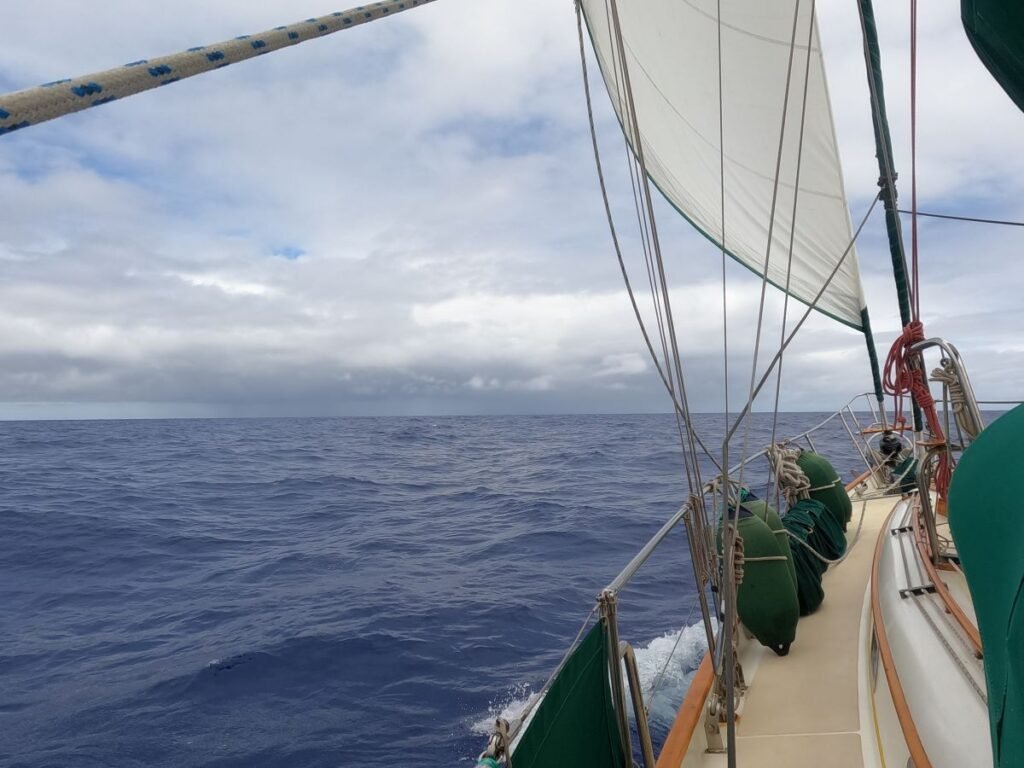
Day Four
To read the daily passage report click here.
I don’t think I’ve used the word squall so much as I have over the last few days. A nasty one hit just after sunset. Although it was so cloudy, it was hard to know if the sun had set or not. However, the sky darkened much more than it felt like it should have, and it seemed like we were entering a very gloomy tunnel. It really gave me the jitters. The wind whipped up and I hand helmed to ease the pressure. It was a relief when the rain came.
That was the last of the worst of the overnight squalls. A few small ones grazed us overnight, but by daybreak the sky all around was clear of them.
On another positive note, the sea had greatly eased and we weren’t getting any waves breaking against the hull. In previous days, a couple of these waves hit hard enough that they splashed right over the sprayhood, giving us a surprise drenching in the cockpit. After that, I chose to sit on the downward side of the cockpit where the waves couldn’t reach.
Emerald isn’t as heeled over as she was on previous days also, making moving around much easier.
Our morale was boosted further as we passed half way on Tuesday evening.

Day Five
To read the daily passage report click here.
This was our favourite day. The afternoon was glorious, with wall to wall blue sky and a sparkling, calm, deep blue sea. As an added bonus, the squalls stayed away.
We took advantage of the lighter winds and Emerald’s slower movement for a good tidy up. I had a wander up to the bow for a change of view and to do a quick check over.
The day rounded off with the first sunset we’d seen on passage.
But unfortunately the champagne sailing conditions didn’t persist. As night descended, the wind dropped away to nothing, and what little there was was now blowing from the north.

Day Six
To read the daily passage report click here.
In the evening of day six, we furled the foresails and turned on the engine. We talked through our options, one of which was to wait at sea until more favourable winds came along. However, when we checked the forecast, it wouldn’t possibly happen until Monday. We’re not hard core sailors, and the thought of just bobbing about for three days whilst so close to our destination didn’t really appeal. So, time for the engine.
The night remained calm, but we didn’t get much sleep due to the heat and noise of the engine. A pleasant afternoon followed. However, as we moved into our final night, the clouds built again and we had a few longer rain showers.
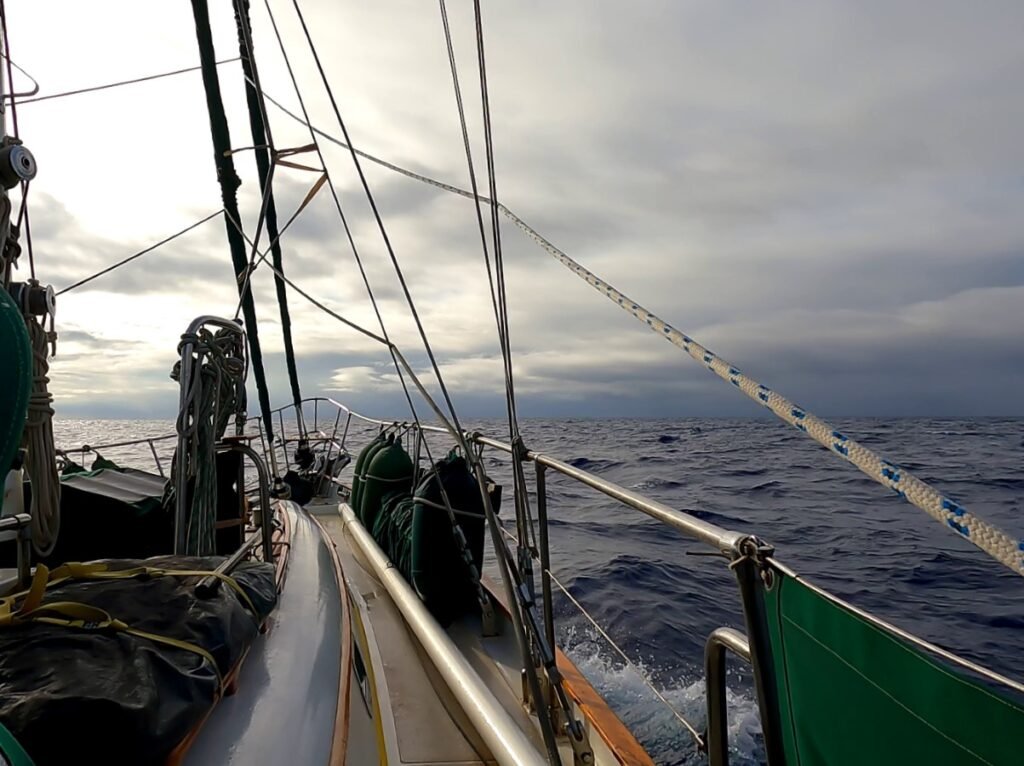
Day Seven
I won the land-ahoy award as at 9pm Friday evening I spotted a darker shape ahead briefly visible amongst the dark clouds. We were 40nm away, and as darkness settled in, the shore lights steadily separated from an amorphous blob into distinct sources. The lighthouse steadily blinked its pattern at us to reassure us that we were still on course.
Our seventh day on passage ended around 5:30 in the morning as we dropped the anchor in 10m of water on the east side of Praia Formosa. Dawn had yet to arrive and the thought of entering an unknown marina in the dark and in our sleep starved state didn’t appeal. We did the minimum of tidying, then grabbed a few hours of sleep before waking to a beautiful view.
The water was the clearest we’ve seen for a long time, with the anchor and the sea bed clearly visible. Fish swam around Emerald’s hull. Some fish became over friendly with Colin when he stepped down our stern ladder to remove the Hydrovane rudder. They darted at his legs, giving him little nips. He did a sterling job of removing the Hydrovane pin and rudder whilst under attack from the locals.
Mid morning we headed off to the marina.


Watches
We followed our usual pattern of 3 hour watches between 10pm and 10am. I take the first watch as I’m good at staying awake late. Coupled to this I have a body clock that really doesn’t want to sleep before midnight unless I’m really exhausted. Whereas Colin has no problems with going to sleep at any time.
During the day we napped as required depending on how well we slept overnight.

Starlink
We’d only installed and commissioned the Starlink system two days before departure. We admit it was a bit last minute for our liking, but other, unexpected things got in the way. Colin built a mount for it on the side of the solar arch and we set it to FLAT mode. As the name implies, this means it remains flat during use, rather than trying to tilt itself towards the satellites.
It was a game changer for communicating whilst far offshore. On passage we usually obtain GRIB files and send plain text updates to our blog and NOFOREIGNLAND via our SSB radio. We can also receive plain text messages from email addresses that we have previously configured with our WinLink account.
With the Starlink we could still do all of this but now the forecasts were much more detailed and with a choice of models. We saved forecasts from the Windy app on an Android phone using a screen recorder app.
A huge nice to have was the ability to keep up with news from family, friends and the rest of the world. The UK General Election took place whilst we were at sea, and we fired up the system at times of important announcements. Plus, adding photos to our social media pages enhanced our daily passage updates.
The biggest reassurance for having the system for me is for emergency use. Fortunately, we didn’t need to use the system in this way.
Practicalities of Using Starlink at Sea
We decided to only turn the system on when we needed it, rather than having it powered up 24/7. This removed the temptation to spend the whole day surfing. During the passage we turned it on once a day, generally in the afternoon when the batteries were full.
Acquisition of a signal took only 5 minutes on a calm day but averaged nearer 30 minutes on the other days.
We used 3.4GB of data over the seven days, costing E2.31 a GB. Once arrived at Santa Maria, we turned off Mobile Priority.

Steering
We set off using the autopilot and we’re not really sure why, but we left it at that for the first few days. On Wednesday afternoon Colin went to the aft deck and switched to Hydrovane steerage.
It is much more efficient steering to the wind with the Hydrovane rather than to a bearing with the autopilot. The autopilot dues have a wind steering option, but the same damaged communications card that impacts the radar, also impacts the autopilot wind steering. So, another good reason to get it fixed!


The Engine
Despite the engine starting and running well since the rebuild, we are still completely paranoid about it. Every time we go to start it, we hold our breath whilst the glow plugs warm up, not letting it out until the engine has purred into life.
After the will-it-start paranoia, our next big concern is for how many hours we can run it for. When we started this passage, we knew we had the prospect of at least a day of motoring ahead of us. At departure we’d put around 10 running hours on the engine since leaving the boatyard, and always in blocks of only a couple of hours.
We both worried about it going bang, and every tiny engine noise change increased our paranoia. Most of the noises were imaginary and generated by our sleep starved heads. Due to the noise and heat from the engine, sleeping below became quite challenging. I woke up from one poor sleep convinced it had change tone. It was just the turbo, which always makes that noise.
As it was, the engine ran perfectly reliably, with temperature and oil levels staying steady at their correct values. I suspect we will always have a tiny bit of worry over the engine, but this long engine run has really boosted our confidence in it.
The engine used a few millilitres of coolant due to a tiny coolant leak, and a third of a litre of oil. We suspect that the turbo has an oil leak due to damage to its seals sustained when the salt water got in. Still, it’s not a huge amount of oil given it ran continuously for 31 hours. We can live with it for the time being.
Breakages
After the issues with the clutch and the genoa furling line were resolved, we weren’t troubled by any other major problems.
A minor concern was that there was more water in the bilge than expected. We did some investigating, such as checking seacocks and decided the water was likely due to waves breaking over the bow and running down into the anchor locker, and then back along the hull into the bilge. As the sea state eased, the amount of water subsequently decreased, confirming this suspicion.
Water was also dripping slowly through the porthole over the chart table. Having tightened up the closing nuts, a few drips of water still broke through when a wave broke onto deck. The proper fix is to remove the port and reseal it, but that’s a big job for another time. In the interim we stuffed it with paper towels and the water flow was so small that they did the trick.
The rev counter for the engine has an intermittent fault. It starts off working when the engine starts, but soon after drops back to zero. We marked the usual position of the throttle lever in case we needed to adjust the revs at any point.
Things Spotted
We saw a couple of ships as we passed Tenerife, but they were all far enough away not to bother us. After that, sightings were few and far between.
Wildlife
The graceful shearwaters provided a welcome distraction to looking at instruments, grey sky and sails. I think they are incredibly elegant as they effortlessly skim the waves.
Colin saw a dolphin. And a couple of flying fish sadly lost their lives having being washed or flown onto deck.
Pat the Pidge
The biggest wildlife encounter was with Pat the racing pigeon. It flew in on Sunday evening, making a few go-arounds and aborted landings on the solar panels, before choosing a patch of bimini for a successful landing. Having said hello, we then had to do some sail work, which spooked it. Pat retreated to the dinghy, where it spent the night.
The following morning, during a light rain shower, Pat appeared in the cockpit. It tried to move around, but struggled to find a grip on the wet, slippery surfaces. Eventually it found a more secure spot and settled down. It wasn’t the best of locations, wedged in next to the main sheet. But we didn’t need to trim at the moment, so it could stay.
The poor thing was looking quite worn out. The rings on its legs implied it was a racing pigeon. But where was it going and where had it come from? We put some water in a cup, which it gulped down, repeating this several times. I was amazed at how much water such a small creature could take in. For food we tried some seeds, but it wasn’t keen.
Pat allowed me to get quite close, and permitted me to gently stroke its feathers. After filling up on water, it had an explore of the cockpit before heading back to the dinghy for another night.
On Tuesday morning, Pat flew away for good. We hoped it found its way home.




Meals on Passage
During the weeks before the passage, I’d been making portions of meals to go in the freezer. We had 5 ready to be warmed up meals: two chillis, a chicken curry, a chicken fajita and a jerk pork. On top of that, the day before departure I cooked all the veg that we had left. This was divided into portions that could be defrosted and mixed with a can of tuna, fresh pasta and a sauce. Along with a first day meal cooked the day before, all in we had the potential for 9 meals.
For the first day, seasickness meant neither of us felt like eating a meal, so we had cake instead. I know, probably the worst thing to eat with a queasy stomach, but it worked. Maybe it was the sugar, or just the comfort of eating something chocolaty.
We tended to eat our main meal mid-afternoon. Colin took the next day’s meal out of the freezer at the same time and put it in the fridge to slowly defrost. Cooking involved simply warming up the mix in one pot and serving, usually with a sprinkling of fresh spring onions on top. To some meals we added a good dollop of guacamole or grated cheese. As an accompaniment we used wraps and nachos.
As the week went on my appetite increased from nothing to ravenous. We had snacks of fruit, nuts and biscuits and I grazed my way through the day and night.

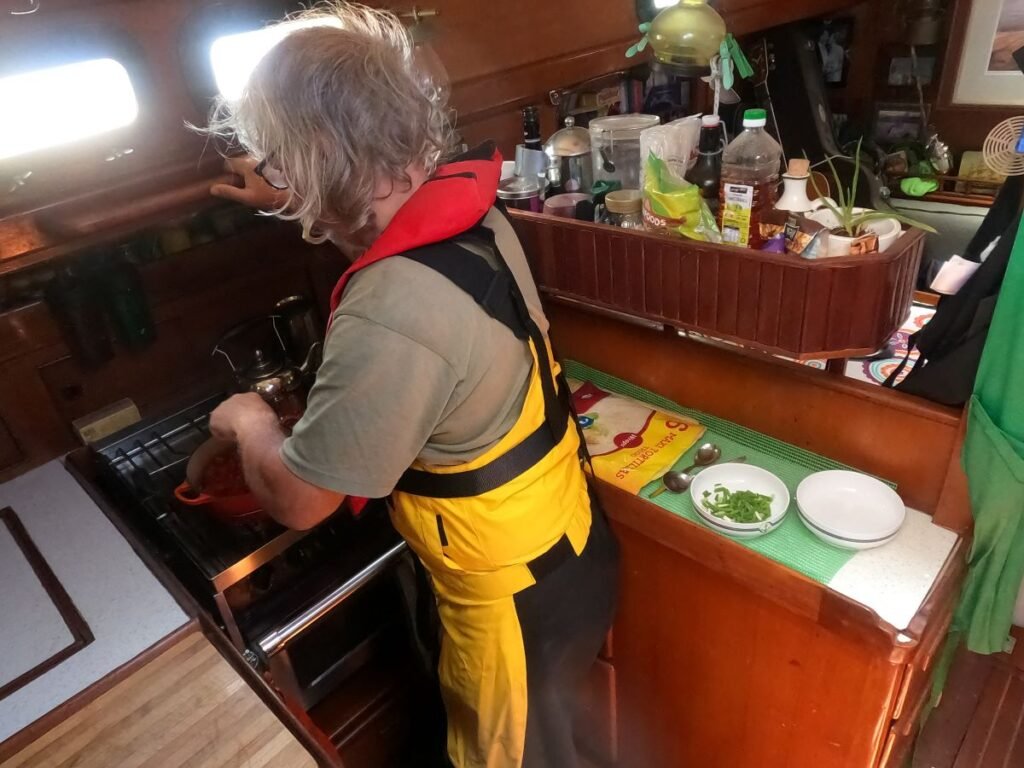
Entertainment on Passage
We read a lot on passage and I also used puzzle books to keep my mind occupied. To this I added a selection of downloaded podcasts and audiobooks. On passage we sometimes listen to music via a speaker, but never at night as it disturbs the off watch.
I’ve tried using headphones before, but I really dislike the disconnect they create with my surroundings. Especially as a change in sound is often the first warning of something changing, particularly in the dark. However, for this passage I tried using some Shokz open headphones and they were fantastic. I could still hear the wind, or a flap of sail, and the drone of the engine, whilst being able to clearly hear the narration of a book. Night watches were transformed as I sang along to tunes to pass the time. The watches seemed to go much faster.
The Fear of Cabin Fever
One of my concerns about the prospect of an at least 6 day passage, was the fear of cabin fever from a lack of activity. I walk or run most days, and I wasn’t sure how I’d react to being confined to a small area of boat.
Over the first few days, it didn’t bother me. We were in a constant state of motion just sitting still as our bodies adjusted and compensated for Emerald’s movement through the waves. Besides sleeping, the general jobs of living took up more time and effort than when still. Occasionally I’d hand helm to break the monotony of a night watch.
However, on Thursday, I had a brief bout of restlessness. It turned out to be a lovely day with blue sky and the right amount of wind and waves to have Emerald moving comfortably. I took a walk to the bow (clipped on) to take some photos and get a welcome change of view.
After that, the knowledge that we were almost there quelled any further cabin fever. Coupled with the lack of sleep due to the engine noise, I was quite happy sitting and relaxing.
I did do a few standing exercises such as knee raises and keeping up with my Achilles leg raises. But it wasn’t easy with the boat heeled over or moving along. Arm exercises were easier, as I could do them whilst sat. If anyone has any suggestions for exercises at sea, please let me know in the comments.
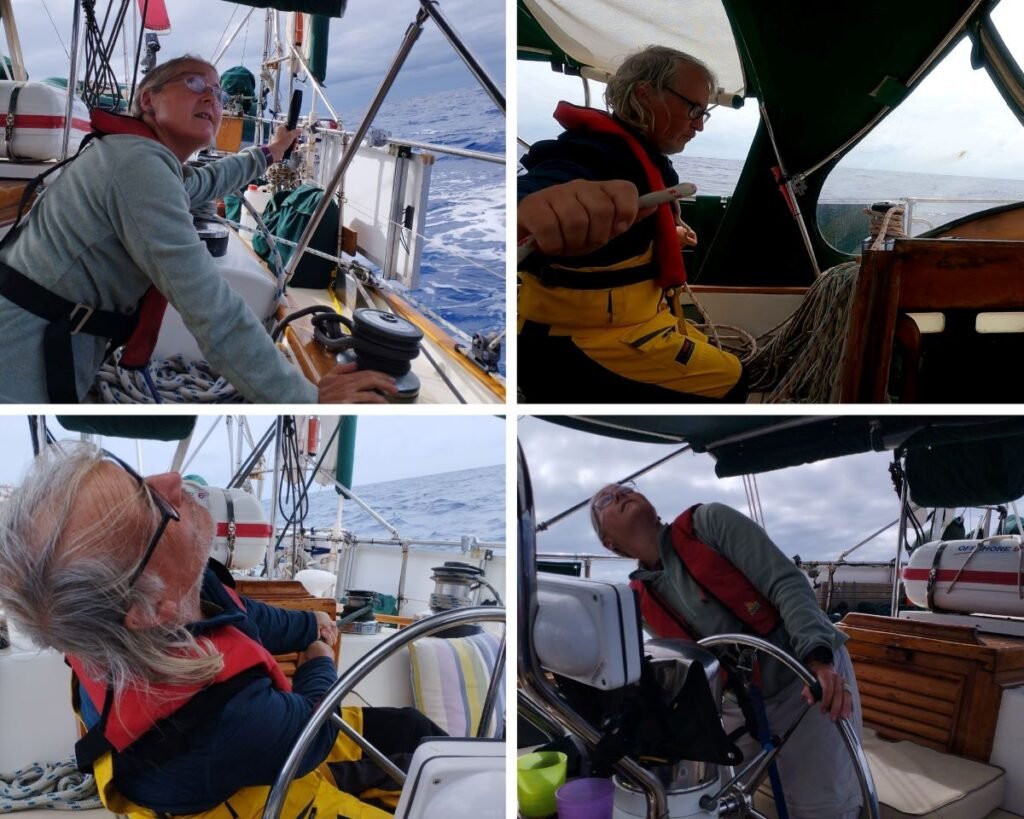
Conclusion Sailing Canary Islands to the Azores
The passage was a great step up in our length of time offshore. We learnt a lot and have a short list of small jobs that should make the next sail even better.
The journey took us 6 hours short of 7 days. Others may have done it quicker, but we sail cautiously. We’d rather arrive with both us and Emerald in one piece than battered and bruised. Although, thinking about it, I have many bruises despite the cautiousness!
Some sort of electric winch is definitely in our future. Trimming and furling the staysail and genoa sail was manageable for us, but reefing the main became hard work. On a day sail we’d generally only raise and lower the main once, but this multiday passage called for putting reefs in and out, sometimes several times a day. The effort increased as our sleep began to get whittled away.
The improved solar array kept up with our demands, even during the cloudy days and when using the power hungry autopilot.
The Weather
The wind and sea state was as expected, and we were pleased with how well Emerald sailed to windward, laden down as she is. What was unexpected was the number of squalls which roamed about almost every day. We don’t know if that’s normal for that stretch of ocean, or was due to a particular weather pattern, but it’s something to investigate further. Obviously repairing the radar will help alert us to their presence at night.
Closing the Circle
In our plans from two years ago, we should have been arriving in the Azores around early July after a pitstop in Porto Santo. But, the engine had other ideas. So, in a way it was a good closing of that stressful period of our history with the engine successfully powering us on to our destination on the final day.
Love / Hate or a Bit of Both?
I was worried that I would really hate the sail, especially with the lack of land time. However, I’d go so far as to say that I enjoyed large parts of it, whilst enduring others. I would quite happily never see a squall or have to use the word ever again.
But really it’s the sense of achievement of “a successful navigation across an ocean to a tiny target” that’s the reward.
Just the two of us and Emerald doing what she does, keeping us comfortable and safe.
Would we do it again? Definitely!
The Social Media Bit: Want to Follow Us?
If you’d like to follow us on other social media platforms (Facebook, Instagram and YouTube), you can do so by using these links:
Or use the link below to track our voyage on NoForeignLand.com.
And finally, you can sign up to receive email notifications of new blogs using the subscribe box at the bottom of this page.
Thank you from Nichola & Colin

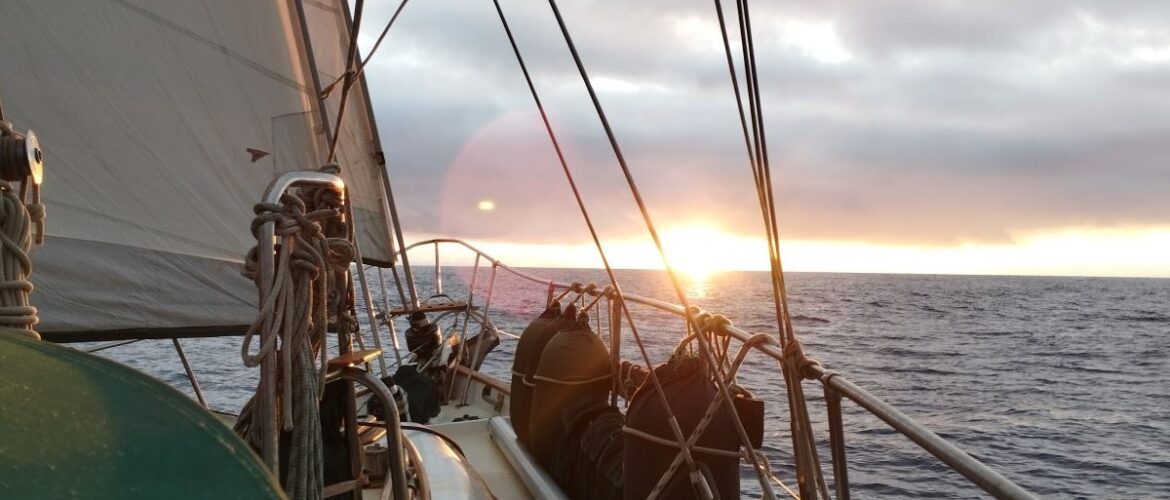


Fantastic log!! I hope you made a meal of the flying fish who gave up their lives on your deck? Deelish!! Also toast and strawberry jam is my top tip.. it settles the stomach but if you are sick, it tastes almost as nice the second time round lol.. Squalls absolutely suck, especially in the dark!! Nobody likes them!!!
Steady wins the day!! Congrats on an epic adventure!!
Thanks Mark! Toast and jam sounds good, something sweet and I’ve always approved of food that tastes good in both directions Alas, we think the fish had been festering on deck for a few days so probably past its best before!
Thoroughly enjoyed reading that. You brought the passage to life and I could easily imagine myself there.
Cheers Bruce, that’s lovely of you to say
Nice one you two. We have accepted ageing and invested in an Ewincher to help with our monster mainsail. It really does the work and can be used in any winch ,battery lasts for ages and easy to recharge on dc or ac! Also good to put someone up the mast . Love Tony and Sallyxxxxx
Thank you for the review, an ewincher does sound like the way forward, why struggle when there’s a solution out there? Hope all is well with you two, love N&C xxx